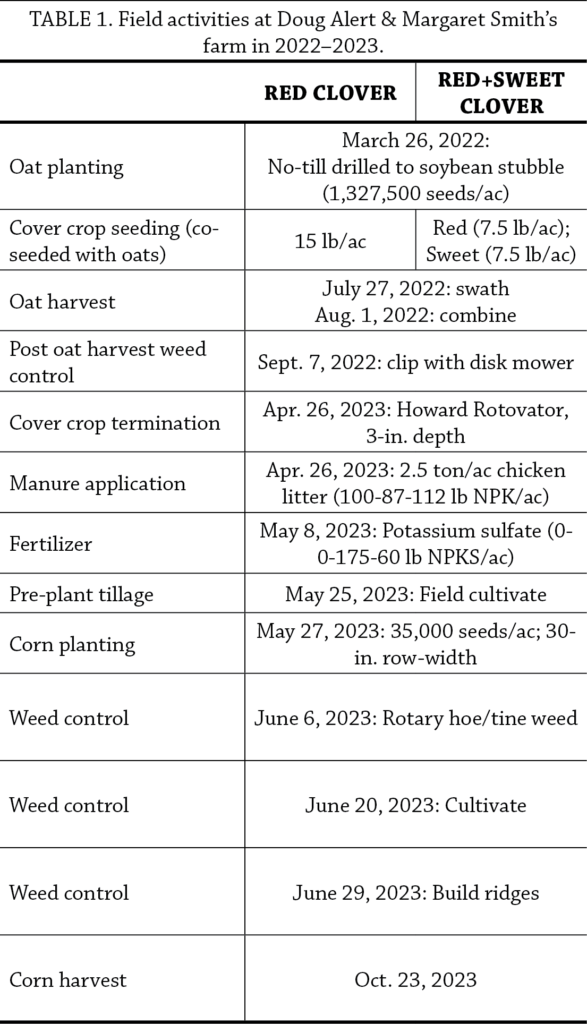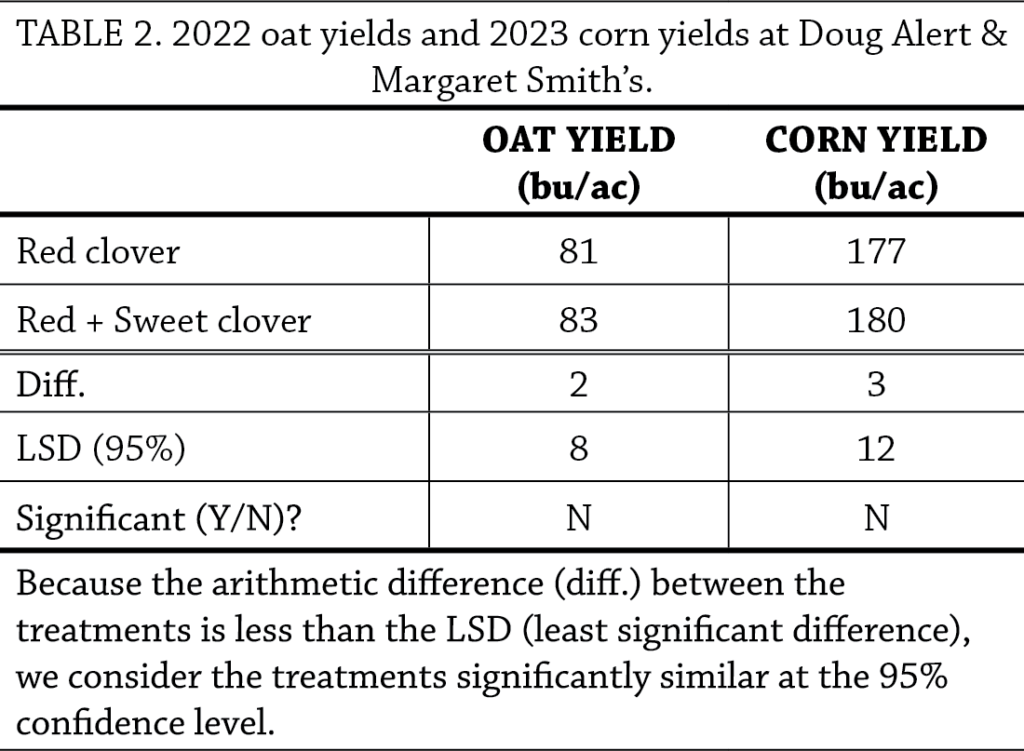This research report was funded by Cargill.
In a Nutshell:
- Green manure cover crops like clovers are often used by organic farmers to provide soil fertility.
- Doug Alert and Margaret Smith have been using red clover as a cover crop between small grains and corn in their organic crop rotation for years. Ever looking for improvements, Alert and Smith wondered whether a mix of sweet clover and red clover would be more drought resistant and provide an extra boost to corn yield compared with red clover alone.
Key Findings
- Treatments of red clover and red + sweet clover cover crops were co-seeded with oats in 2022. Neither 2022 oat yield nor 2023 corn yields differed significantly between the two treatments.
- Sweet clover did not survive the winter of 2022-2023, perhaps because of fall clipping timing or drought conditions. This led to a less dense clover stand in the red clover + sweet clover treatment compared to the red clover only treatment.
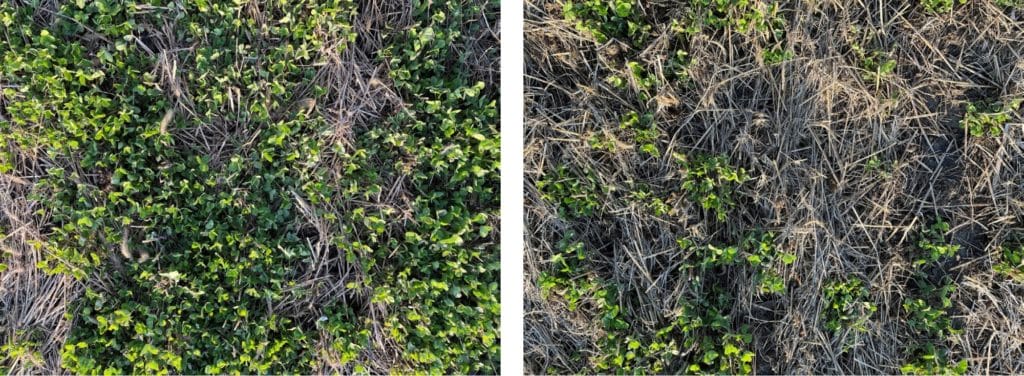
Red clover stand (left) was denser in spring of 2023 than the red clover plus sweet clover stand (right). Photos taken April 26, 2023.
Background
Doug Alert and Margaret Smith have a long history of underseeding a red clover cover crop into their oats in a soybean-oats-corn organic rotation. They like this cover cropping approach, and it has consistently performed well, however, in 2020 and 2021 they had significant red clover death in the late summers due to drought conditions. Sweet clover has a longer taproot than red clover, so Alert and Smith decided to try seeding a red + sweet clover mix and comparing this to their red clover only cover crop to see if the mix survived better in dry weather and whether it affected oat or corn yield.
Methods
Design
To determine the survival and the effect of red and sweet clovers on 2022 oat yield and 2023 corn yield, Alert and Smith established two cover crop treatments:
- Red clover: Red clover cover crop co-seeded with oats in spring 2022.
- Red + sweet clover: Blend of red and sweet clovers co-seeded with oats in spring 2022.
Both treatments were replicated six times for a total of 12 strips (Figure A1). Each strip measured 30 ft wide × 2,175 ft long. Field management is provided in Table 1.
Measurements
Alert recorded oat yields from each strip during harvest in 2022 (Aug. 1) and corn yields from each individual strip during harvest in 2023 (Oct. 23). Oat yields were corrected to 14% moisture and corn yields were corrected to 15.5% moisture.
Data analysis
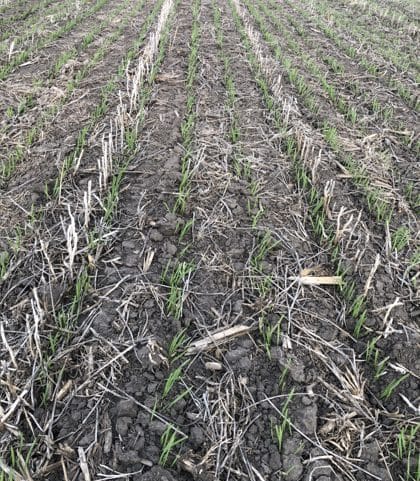
Oats growing through soybean stubble. Though clovers were co-seeded with oats in late March, they are not yet visible in this picture. Photo taken in mid-to-late April 2022.
We used Fischer’s LSD (least significant difference) at a 95% confidence level to determine if there were significant differences between the two cover crop treatments. For oat and corn yield, the difference between any two treatments is compared with the LSD. A difference greater than or equal to the LSD indicates the presence of a statistically significant treatment effect, meaning one treatment outperformed the other and the farmer can expect the same results to occur 95 out of 100 times under the same conditions. A difference smaller than the LSD indicates the difference is not statistically significant and the treatment had no effect. We could perform this analysis because Alert and Smith’s experimental design involved replication and randomization of the treatments (Figure A1).
Results and Discussion
Yield
Oat yields in 2022 were statistically similar between the treatments (Table 2). In other words, the cover crops co-seeded with the oats had no effect on oat yields. Across both treatments, the average oat yield in 2022 was 82 bu/ac. Corn yields in 2023 were statistically similar between the treatments as well (Table 2). Across both clover cover crop mixes, average corn yield in 2023 was 178 bu/ac.
Clover performance
Though they did not measure clover stand counts, Alert and Smith observed that the sweet clover did not survive the winter of 2022-2023. “The sweet clover didn’t survive our dry conditions and/or summer clipping schedule,” they reported. In researching this mortality issue, Alert and Smith found several resources that warned that sweet clover plants cut in September experience high winter plant mortality compared with plants clipped in November [1], and that plants must be clipped at about 10 in. to allow for regrowth from buds at this level of the branches [2,3]. Because Alert and Smith cut the clover on Sept. 7, 2022, and cut it to a height of 3 in., it seems likely that these management practices led to the death of most of the sweet clover plants. However, the red clover plants grew back nicely in the late fall of 2022 and spring of 2023. “We added the sweet clover, thinking that having more of a tap root it would do better in drier conditions. It didn’t, red clover is still hard to beat.”
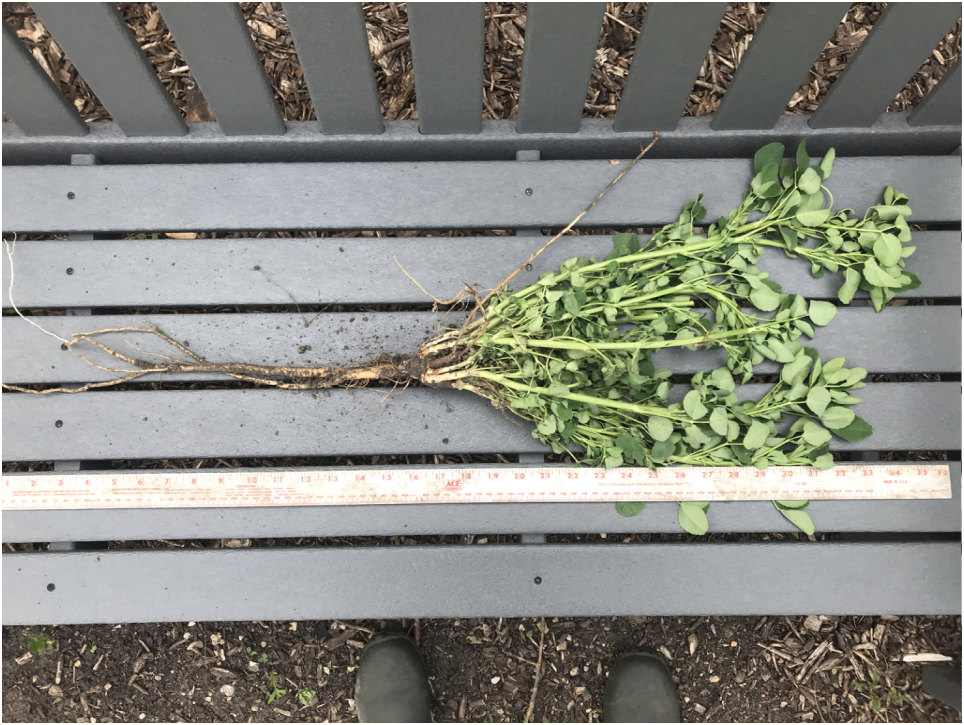
One of the rare surviving sweet clover plants at just over a year old pulled prior to termination. Photo taken May 17, 2023.
Conclusions and Next Steps
Alert and Smith report that they are unlikely to try sweet clover again as an co-seeded cover in their oats because it does not work well with their existing management practices.
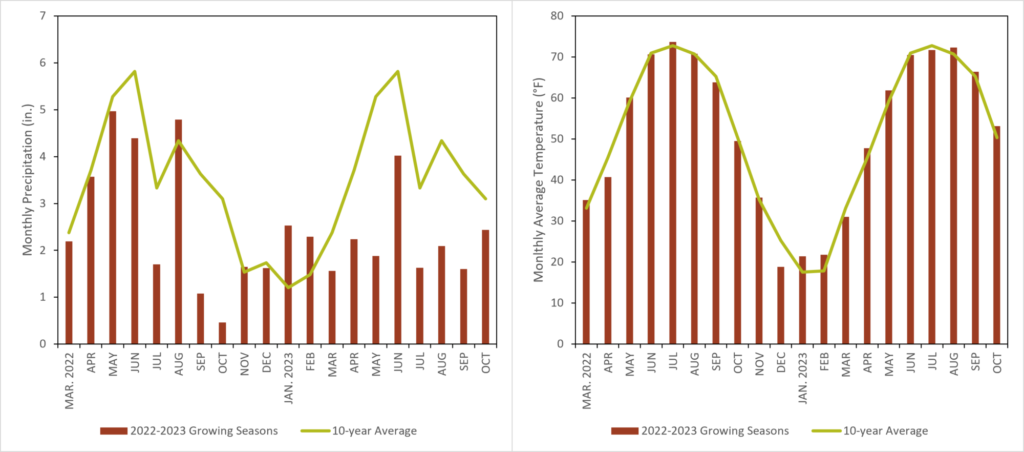
Figure A2. Weather in the 2022-2023 growing seasons at Hampton [4]. Monthly cumulative precipitation is shown in the left panel and monthly mean temperature is shown in the right panel. Click to enlarge.
References
[1] “Vegetation Management Guideline: White Sweet Clover, Yellow Sweet Clover,” Illinois DNR, 2017. [Online]. Accessed March 2023. Available: https://dnr.illinois.gov/content/dam/soi/en/web/dnr/inpc/documents/vmg/vmg-23-sweet-clover-revised-2017.pdf
[2] J. H. Martin, W. H. Leonard, and D. L. Stamp, Principles of Field Crop Production. Macmillan, 1976.
[3] M. Collins, C. J. Nelson, K. J. Moore, and R. F. Barnes, Forages, Volume 1: An Introduction to Grassland Agriculture. John Wiley & Sons, 2017.
[4] Climodat Reports, “Iowa Environmental Mesonet.” Iowa State University. [Online]. Accessed March 2023. Available: http://mesonet.agron.iastate.edu/climodat/


